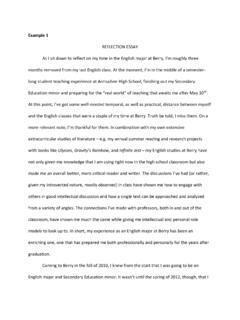Transcription of The Meaning of Death in Shakespeare’s Hamlet
1 Full Terms & Conditions of access and use can be found : A Quarterly Journal of Short Articles, Notes andReviewsISSN: 0895-769X (Print) 1940-3364 (Online) Journal homepage: Meaning of Death in Shakespeare s HamletJeffrey WilsonTo cite this article: Jeffrey Wilson (2019): The Meaning of Death in Shakespeare s Hamlet , ANQ:A Quarterly Journal of Short Articles, Notes and Reviews, DOI: link to this article: online: 03 Dec your article to this journal View related articles View Crossmark dataThe Meaning of Death in Shakespeare sHamletJeffrey WilsonThe common theme of nature, Claudius says inHamlet,is Death of fathers ( 04). All wholive must die, but Death always feels, in Gertrude s words, so particular ( ). Since Death is alsoa common theme inHamlet, this essay asks what the particular way characters die reveals aboutShakespeare s Hamlet dies off-stage, poisoned by his ambitious brother. Polonius dies at the threshold betweenthe front- and back-stage, stabbed by a vengeful Prince Hamlet , who mistakenly thinks Polonius isClaudius.
2 Ophelia dies off-stage, committing suicide by drowning herself. Rosencrantz and Guildensterndie off-stage, executed on Hamlet s orders. Gertrude dies on-stage, accidentally poisoned by dies on-stage, stabbed by his own poisoned blade. Claudius dies on-stage, stabbed and poisonedby a vengeful Hamlet (the stabbing seems to be the fatal blow, since he dies immediately). Hamlet dieson-stage, stabbed by Laertes with a blade poisoned by Claudius (it seems to be the poison that kills him,since he takes a while to die). Are there any patterns here in on-stage versus off-stage deaths? inpurposeful versus accidental deaths? in poisonings versus stabbings? in men sversuswomen s deaths? inroyals versus nobles deaths? Do the ways Shakespeare s characters die relate to the ways they lived? Isthe reason a character dies related to the manner of Death ? Does the form these characters deaths takesuggest anything about what Shakespeare understood tragedy to be, and how he went about writing it?
3 In response to these questions, this essay presents two central ideas. First, Shakespeare dissemi-nated the Aristotelian notion of tragic necessity a causal relationship between a character shamar-tia(fault or error) and the catastrophe at the end of the play from the protagonist to the othercharacters, such that, inHamlet, those who are guilty must die, and those who die are guilty. Second,there exists inHamleta positive correlation between the severity of a character shamartiaand the spectacularity of his or her Death that is, the extent to which it is presented as a visible andvisceral spectacle came to these conclusions through a mixture of qualitative and quantitative reasoning. First I listedout all the deaths in the play, noting that 9 of the 11 central characters die (in order, King Hamlet ,Polonius, Ophelia, Rosencrantz, Guildenstern, Laertes, Gertrude, Claudius, and Prince Hamlet all die,while Horatio and Young Fortinbras do not).
4 To be sure, this is a subjective determination of what countsas a central character : the First Player has more lines (96 lines) than the Ghost (95 lines), and the FirstClown has more (94 lines) than Guildenstern (53 lines). Young Fortinbras has even fewer lines (27 lines).Yet, in considering the central plot with Norway threatening Denmark, King Hamlet s assassinationand return from the grave sends his son in search of vengeance King Hamlet and Young Fortinbras arecentral to the tragic (in contrast to comic) elements of the I started looking for patterns, identifying a series of relevant considerations: the order inwhich the deaths occur, the gender of the characters who die (male or female?), the class of thosewho die (royal or noble?), the place of the Death (on-stage or off-stage), the manner of Death (stabbed, poisoned, etc.), the person responsible for the Death (brother, friend, son-in-law, etc.), thedeliberateness of the Death (accidental or purposive), the gender of the responsible party, the class ofthe responsible party, and thehamartiaof the character who dies.
5 Most of these categories arestraight-forward, self-explanatory, and not really open to interpretation, but the final consideration hamartia merits some versions of one or more of the figures in the article can be found online 2019 Taylor & Francis Group, LLCANQ: A QUARTERLY JOURNAL OF SHORT ARTICLES, NOTES, AND termhamartiacomes from the theory of tragedy developed in Aristotle Dictionarydefines it as the fault or error which entails the destruction of the tragic hero ( hamartia, n. ). A fault involveswho someone is, a bad personality trait or personal weakness. Incontrast, an error involveswhat someone does, a mistaken or miscalculated action. Whether a fault oran error, the protagonist shamartia, Aristotle said, should cause the catastrophe that comes at the endof the play, resulting in Death and the downfall of nations. That catastrophe creates pity in the audiencebecause it is disproportionately large compared to the minuteness of thehamartia, yet the audiencestill sees how the protagonist shamartiadid in fact bring about his or her own causal relationship betweenhamartiaand catastrophe is especially significant inHamlet,where Shakespeare extrapolated the treatment of the protagonist shamartiain classical tragedy toapply it to other characters.
6 Many in the play, not just the protagonist, are hoist with his [or her]own petard, to quote Hamlet ( ). For instance, Rosencrantz and Guildenstern die by theirown insinuation ( ). And Laertes is justly killed with [his] own treachery ( ). The playis filled, as Horatio summarizes it at the end, with purposes mistook / Fall nonth inventors heads ( 368). This is Shakespeare s dissemination of tragic necessity inHamlet. And here the logicof a necessary connection between an error or fault and a character s downfall opens up thepossibility of reasoning in reverse: if a character inHamletdies, he or she is guilty of classified King Hamlet shamartiaas pride based on Horatio s description of King Hamlet s emulatepride in dueling with Old Fortinbras ( ). Pride is a commonhamartiain tragedy, andHoratio s word, emulate from the Latinaemul ri, to rival throws pride upon both OldFortinbras (in proposing the duel) and King Hamlet (in accepting it) alike.
7 Polonius shamartiaisdeception, specifically his effort to investigate Hamlet s madness and by indirections find directionsout ( ). Thus, there is a conceptual affinity between Polonius shamartiaand his Death whilehidden behind a curtain spying on Hamlet , who calls Polonius an intruding fool ( ) andchides the dead man, Thou find s to be too busy is some danger ( ). She is often seen asguiltless, but Ophelia shamartiacould be deception based on her role in the investigation of , at least, is how Hamlet characterizes her when he scolds, God hath given you one face, andyou make yourselves another ( 44). Rosencrantz and Guildenstern are also guilty of deceit, Hamlet seeing a kind of confession in [their] looks when they first meet ( ).But thehamartiaof the other four characters who die is not as easily settled. Like Ophelia,Gertrude is guilty of going along with the investigation of Hamlet , but when she speaks of the blackand grained spots in her soul, it is in response to Hamlet s complaint that she married her deadhusband s brother ( 90).
8 She s guilty of deception, yes, but also what the ghost calls damnedincest ( ). As a foil forHamlet ( ), Laertes is clearly guilty of revenge, each son seekingjustice for the murder of his father. I ll be revenged / Most thoroughly for my father, Laertes criesupon coming back to Denmark. But in conspiring with Claudius to rig the duel against Hamlet bypoisoning his blade I will work him, Claudius says of Hamlet , to an exploit now ripe in mydevice ( 62) Laertes also parallels thehamartiaof his father and sister, deception. Hamlethas the exact same doublehamartia, both revenge and deceit. Each theme is marked out in Act I,Scene v, where first the Ghost tells Hamlet to revenge his foul and most unnatural murder ( ),then Hamlet declares his plan to put an antic disposition on ( ). Claudius too has a doublehamartia, not revenge-and-deceit, but ambition-and-deceit. In his soliloquy of repentance, Claudiusrefers to [his] own ambition in killing his brother ( ).
9 That was Claudius s initial deceit theforged process of [King Hamlet s] Death ( ) which is compounded when Claudius concoctsthe plan for himself, Polonius, Gertrude, Ophelia, Rosencrantz, and Guildenstern to work as lawfulespials on Hamlet ( ).Hamartia-hunting is a dangerous game, filled with questions open to interpretation, but thedeterminations I ve made are represented inTable 1, which also lays out the factors I consideredwhen searching for patterns related to the deaths that occur significant patterns in gender emerged: the two women die in very different ways, Opheliacommitting suicide off-stage, Gertrude poisonedon-stage. Some of the males die off-stage (King2J. WILSONH amlet, Rosencrantz, and Guildenstern); some die on-stage ( Hamlet , Claudius, and Laertes); andPolonius dies in a liminal space at the edge of the stage, neither fully on nor fully off. No patterns was a pattern with class: all the royals (King Hamlet , Queen Gertrude, King Claudius, andPrince Hamlet ) are poisoned, which speaks, no doubt, to the theme of decay and rot Shakespeareused to characterize the Danish royalty: Something is rotten in the state of Denmark ( ).
10 Atthe same time, Laertes is also poisoned, which disrupts the pattern, since he s merely noble, notroyal. Arguments could be mustered to explain what s going on here, but it s not the clean patternI was hoping to patterns have similar asterisks. Looking at the order of the deaths, the earlier ones occuroff-stage, and most of the later deaths occur on-stage, but Rosencrantz and Guildenstern disrupt thatpattern. Looking at gender, most of the males are stabbed (Claudius, Hamlet , Polonius, and Laertes,while with Rosencrantz and Guildenstern some similarly violent form of execution, such as behead-ing, seems likely), but King Hamlet is poisoned. Looking at class, Claudius, Queen Gertrude, KingClaudius, and Prince Hamlet all royals die on-stage, but King Hamlet also a royal dies off-stage. Ophelia, Rosencrantz, and Guildenstern all nobles die off-stage, but Laertes also a noble dies on-stage. Looking at manner of Death , King Hamlet and Gertrude were poisoned; Polonius,Laertes, Rosencrantz, and Guildenstern were stabbed (or encountered some other violent Death );Laertes, Claudius, and Hamlet were each stabbed and poisoned; and Ophelia stands alone in were there any patterns in the relationship of the deceased to the killer, or in the gender or classof the killer.







